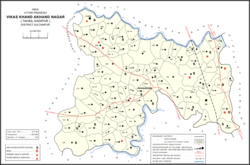Muradabad, Sultanpur
 From Wikipedia - Reading time: 7 min
From Wikipedia - Reading time: 7 min
Muradabad
Murādābād | |
|---|---|
Village | |
 Map showing Muradabad (#190) in Akhand Nagar CD block | |
| Coordinates: 26°14′23″N 82°40′19″E / 26.23979°N 82.67192°E[1] | |
| Country | |
| State | Uttar Pradesh |
| Division | Faizabad division |
| District | Sultanpur |
| Area | |
• Total | 1.613 km2 (0.623 sq mi) |
| Population (2011)[2] | |
• Total | 1,543 |
| • Density | 960/km2 (2,500/sq mi) |
| Languages | |
| • Official | Hindi, Urdu |
| Time zone | UTC+5:30 (IST) |
Muradabad is a village in Akhand Nagar block of Kadipur tehsil in Sultanpur district, Uttar Pradesh, India.[2] As of 2011, it has a population of 1,543 people, in 238 households.[2] It has one primary school and no healthcare facilities and it hosts both a regular market and a weekly haat.[2] It belongs to the nyaya panchayat of Sajampur.[3]
The 1951 census recorded Muradabad (as "Moradabad") as comprising 2 hamlets, with a total population of 484 people (254 male and 230 female), in 83 households and 81 physical houses.[4] The area of the village was given as 435 acres.[4] 55 residents were literate, all male.[4] The village was listed as belonging to the pargana of Aldemau and the thana of Dostpur.[4]
The 1961 census recorded Muradabad (as "Moradabad") as comprising 2 hamlets, with a total population of 555 people (254 male and 301 female), in 93 households and 87 physical houses.[5] The area of the village was given as 435 acres.[5]
The 1981 census recorded Muradabad as having a population of 870 people, in 133 households, and having an area of 172.00 hectares.[6] The main staple foods were listed as wheat and rice.[6]
The 1991 census recorded Muradabad as having a total population of 1,117 people (583 male and 534 female), in 143 households and 136 physical houses.[3] The area of the village was listed as 161.10 hectares.[3] Members of the 0-6 age group numbered 274, or 24.5% of the total; this group was 48% male (131) and 52% female (143).[3] Members of scheduled castes numbered 99, or 8% of the village's total population, while no members of scheduled tribes were recorded.[3] The literacy rate of the village was 55% (336 men and 130 women, counting only people age 7 and up).[3] 297 people were classified as main workers (264 men and 33 women), while 0 people were classified as marginal workers; the remaining 820 residents were non-workers.[3] The breakdown of main workers by employment category was as follows: 165 cultivators (i.e. people who owned or leased their own land); 70 agricultural labourers (i.e. people who worked someone else's land in return for payment); 0 workers in livestock, forestry, fishing, hunting, plantations, orchards, etc.; 0 in mining and quarrying; 1 household industry worker; 1 worker employed in other manufacturing, processing, service, and repair roles; 2 construction workers; 5 employed in trade and commerce; 3 employed in transport, storage, and communications; and 50 in other services.[3]
References
[edit]- ^ "Geonames Search". Do a radial search using these coordinates here.
- ^ a b c d e "Census of India 2011: Uttar Pradesh District Census Handbook - Sultanpur, Part A (Village and Town Directory)" (PDF). Census 2011 India. pp. 539–56. Retrieved 13 November 2021.
- ^ a b c d e f g h Census 1991 Series-25 Uttar Pradesh Part-XII B Village & Townwise Primary Census Abstract District Census Handbook District Raebareli (PDF). 1992. pp. xxiv–xxviii, 324–5. Retrieved 28 November 2021.
- ^ a b c d Census of India, 1951: District Census Handbook Uttar Pradesh (49 - Rae Bareli District) (PDF). Allahabad. 1955. pp. 118–9. Retrieved 28 November 2021.
{{cite book}}: CS1 maint: location missing publisher (link) - ^ a b Census 1961: District Census Handbook, Uttar Pradesh (44 - Sultanpur District) (PDF). Lucknow. 1965. pp. cxxxxli–cxxxlii. Retrieved 28 November 2021.
{{cite book}}: CS1 maint: location missing publisher (link) - ^ a b Census 1981 Uttar Pradesh: District Census Handbook Part XIII-A: Village & Town Directory, District Rae Bareli (PDF). 1982. pp. 284–5. Retrieved 28 November 2021.
 KSF
KSF